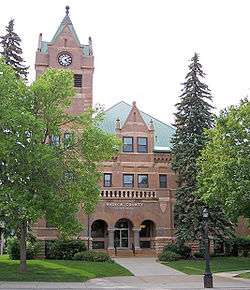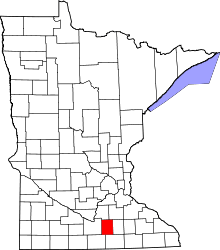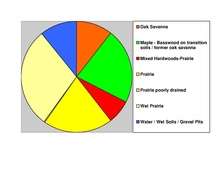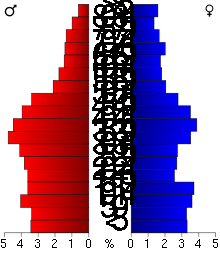Waseca County, Minnesota
| Waseca County, Minnesota | |
|---|---|
 Waseca County Courthouse in 2007 | |
 Location in the U.S. state of Minnesota | |
 Minnesota's location in the U.S. | |
| Founded | February 27, 1857[1] |
| Named for | Dakota word meaning "rich," a reference to the fertile soil in the area[2] |
| Seat | Waseca |
| Largest city | Waseca |
| Area | |
| • Total | 433 sq mi (1,121 km2) |
| • Land | 423 sq mi (1,096 km2) |
| • Water | 9.6 sq mi (25 km2), 2.2% |
| Population (est.) | |
| • (2016) | 18,911 |
| • Density | 45/sq mi (17/km2) |
| Congressional district | 1st |
| Time zone | Central: UTC−6/−5 |
| Website |
www |
Waseca County is a county in the U.S. state of Minnesota. As of the 2010 census, the population was 19,136.[3] Its county seat is Waseca.[4]
Geography
According to the U.S. Census Bureau, the county has an area of 433 square miles (1,120 km2), of which 423 square miles (1,100 km2) is land and 9.6 square miles (25 km2) (2.2%) is water.[5] Waseca is one of seven southern Minnesota counties that have no forest ecosystems, only prairie and savanna soils exist in these counties.

The Le Sueur River flows through part of the county.
Lakes
- Buffalo Lake: in Alton Township
- Clear Lake: in Woodville Township
- Everson Lake: in Blooming Grove Township
- Goose Lake: in Woodville Township
- Hayes Lake: in Blooming Grove Township
- Knutsen Lake: in Blooming Grove Township
- Lake Elysian: almost entirely in Janesville Township, but the northern edge juts into Le Sueur County
- Lilly Lake: in Janesville Township
- Lily Lake: mostly in Iosco Township, but the far western part of the lake extends into Janesville Township and Le Sueur County
- Loon Lake: in Woodville Township-
- Mott Lake: in Freedom Township
- Reeds Lake: in Iosco Township
- Reese Lake: in New Richland Township
- Rice Lake: in Janesville Township
- Rice Lake: there is another, somewhat larger Rice Lake in Woodville Township
- Saint Olaf Lake: in New Richland Township
- Sibert Lake: in Janesville Township
- Silver Lake: in Wilton Township
- Toners Lake: in Iosco Township
- Trenton Lake: the northern third is in Byron Township and the lower two thirds is in Freeborn County
- Watkins Lake: in Woodville Township
Major highways
Adjacent counties
- Rice County (northeast)
- Steele County (east)
- Freeborn County (southeast)
- Faribault County (southwest)
- Blue Earth County (west)
- Le Sueur County (northwest)
Demographics
| Historical population | |||
|---|---|---|---|
| Census | Pop. | %± | |
| 1860 | 2,601 | — | |
| 1870 | 7,854 | 202.0% | |
| 1880 | 12,385 | 57.7% | |
| 1890 | 13,313 | 7.5% | |
| 1900 | 14,760 | 10.9% | |
| 1910 | 13,466 | −8.8% | |
| 1920 | 14,133 | 5.0% | |
| 1930 | 14,412 | 2.0% | |
| 1940 | 15,186 | 5.4% | |
| 1950 | 14,957 | −1.5% | |
| 1960 | 16,041 | 7.2% | |
| 1970 | 16,663 | 3.9% | |
| 1980 | 18,448 | 10.7% | |
| 1990 | 18,079 | −2.0% | |
| 2000 | 19,526 | 8.0% | |
| 2010 | 19,136 | −2.0% | |
| Est. 2016 | 18,911 | [7] | −1.2% |
| U.S. Decennial Census[8] 1790-1960[9] 1900-1990[10] 1990-2000[11] 2010-2016[3] | |||

As of the 2000 census, there were 19,526 people, 7,059 households, and 4,990 families residing in the county. The population density was 46 people per square mile (18/km²). There were 7,427 housing units at an average density of 18 per square mile (7/km²). The racial makeup of the county was 94.65% White, 2.26% Black or African American, 0.59% Native American, 0.46% Asian, 0.03% Pacific Islander, 1.29% from other races, and 0.71% from two or more races. 2.90% of the population were Hispanic or Latino of any race. 47.6% were of German, 15.5% Norwegian, 7.4% Irish and 5.5% American ancestry.
There were 7,059 households out of which 34.70% had children under the age of 18 living with them, 59.00% were married couples living together, 7.80% had a female householder with no husband present, and 29.30% were non-families. 25.10% of all households were made up of individuals and 10.70% had someone living alone who was 65 years of age or older. The average household size was 2.56 and the average family size was 3.07.
In the county, the population was spread out with 25.80% under the age of 18, 8.70% from 18 to 24, 30.00% from 25 to 44, 21.30% from 45 to 64, and 14.20% who were 65 years of age or older. The median age was 36 years. For every 100 females there were 109.30 males. For every 100 females age 18 and over, there were 111.30 males.
The median income for a household in the county was $42,440, and the median income for a family was $50,081. Males had a median income of $34,380 versus $22,630 for females. The per capita income for the county was $18,631. About 4.50% of families and 6.50% of the population were below the poverty line, including 8.80% of those under age 18 and 5.80% of those age 65 or over.
Communities
Cities
- Elysian (partly in Le Sueur County)
- Janesville
- New Richland
- Waldorf
- Waseca (county seat)
Townships
Unincorporated communities
Politics
| Year | Republican | Democratic | Third parties |
|---|---|---|---|
| 2016 | 61.8% 5,967 | 29.4% 2,838 | 8.8% 848 |
| 2012 | 52.5% 5,116 | 44.8% 4,370 | 2.7% 261 |
| 2008 | 52.7% 5,211 | 44.5% 4,401 | 2.8% 276 |
| 2004 | 55.7% 5,457 | 42.6% 4,179 | 1.7% 164 |
| 2000 | 52.0% 4,608 | 41.7% 3,694 | 6.3% 562 |
| 1996 | 37.4% 3,171 | 45.1% 3,819 | 17.5% 1,482 |
| 1992 | 34.6% 3,118 | 34.9% 3,146 | 30.4% 2,742 |
| 1988 | 54.0% 4,471 | 44.9% 3,721 | 1.2% 95 |
| 1984 | 60.6% 5,509 | 38.8% 3,527 | 0.6% 55 |
| 1980 | 51.6% 4,801 | 38.0% 3,535 | 10.4% 965 |
| 1976 | 52.0% 4,582 | 45.5% 4,002 | 2.5% 221 |
| 1972 | 63.9% 5,064 | 34.9% 2,767 | 1.2% 95 |
| 1968 | 56.4% 4,292 | 40.2% 3,057 | 3.4% 256 |
| 1964 | 49.5% 3,570 | 50.3% 3,633 | 0.2% 14 |
| 1960 | 63.4% 4,838 | 36.6% 2,793 | 0.1% 5 |
| 1956 | 67.7% 4,663 | 32.2% 2,215 | 0.2% 11 |
| 1952 | 69.8% 4,962 | 30.0% 2,132 | 0.3% 19 |
| 1948 | 52.6% 3,511 | 46.7% 3,120 | 0.7% 49 |
| 1944 | 65.0% 4,146 | 34.6% 2,207 | 0.4% 22 |
| 1940 | 62.6% 4,515 | 37.1% 2,673 | 0.4% 25 |
| 1936 | 39.1% 2,482 | 55.5% 3,520 | 5.5% 346 |
| 1932 | 34.1% 2,012 | 64.5% 3,805 | 1.5% 86 |
| 1928 | 56.9% 3,251 | 42.4% 2,418 | 0.7% 41 |
| 1924 | 37.1% 2,081 | 7.9% 442 | 55.0% 3,082 |
| 1920 | 71.8% 3,626 | 24.9% 1,257 | 3.3% 168 |
| 1916 | 54.1% 1,522 | 41.9% 1,178 | 4.0% 113 |
| 1912 | 20.5% 553 | 39.4% 1,062 | 40.1% 1,079[13] |
| 1908 | 55.0% 1,455 | 41.0% 1,085 | 4.0% 106 |
| 1904 | 70.1% 1,714 | 25.8% 631 | 4.1% 99 |
| 1900 | 58.5% 1,744 | 38.7% 1,155 | 2.8% 84 |
| 1896 | 58.8% 1,902 | 38.5% 1,244 | 2.8% 89 |
| 1892 | 44.9% 1,090 | 42.9% 1,042 | 12.3% 298 |
See also
References
- ↑ "Minnesota Place Names". Minnesota Historical Society. Retrieved March 19, 2014.
- ↑ Upham, Warren (1920). Minnesota Geographic Names: Their Origin and Historic Significance. Minnesota Historical Society. p. 564.
- 1 2 "State & County QuickFacts". United States Census Bureau. Retrieved September 1, 2013.
- ↑ "Find a County". National Association of Counties. Retrieved 2011-06-07.
- ↑ "2010 Census Gazetteer Files". United States Census Bureau. August 22, 2012. Archived from the original on October 6, 2014. Retrieved October 25, 2014.
- ↑ Nelson, Steven (2011) Savanna Soils of Minnesota. Minnesota: Self. pp. 43 - 48. ISBN 978-0-615-50320-2.
- ↑ "Population and Housing Unit Estimates". Retrieved June 9, 2017.
- ↑ "U.S. Decennial Census". United States Census Bureau. Retrieved October 25, 2014.
- ↑ "Historical Census Browser". University of Virginia Library. Retrieved October 25, 2014.
- ↑ "Population of Counties by Decennial Census: 1900 to 1990". United States Census Bureau. Retrieved October 25, 2014.
- ↑ "Census 2000 PHC-T-4. Ranking Tables for Counties: 1990 and 2000" (PDF). United States Census Bureau. Retrieved October 25, 2014.
- ↑ Leip, David. "Dave Leip's Atlas of U.S. Presidential Elections". uselectionatlas.org. Retrieved 10 October 2018.
- ↑ The leading "other" candidate, Progressive Theodore Roosevelt, received 940 votes, while Socialist candidate Eugene Debs received 63 votes, Prohibition candidate Eugene Chafin received 62 votes, and Socialist Labor candidate Arthur Reimer received 14 votes.